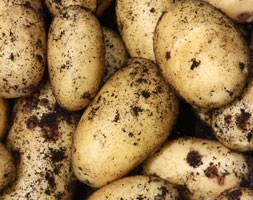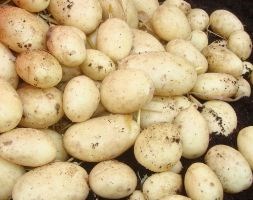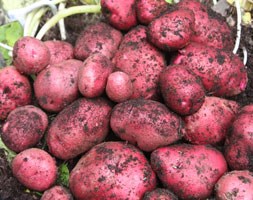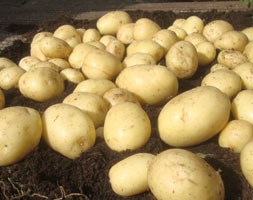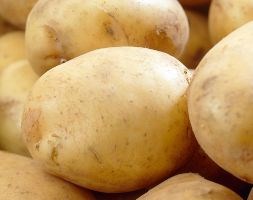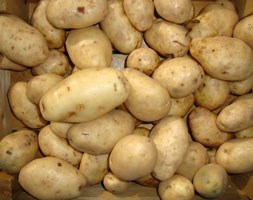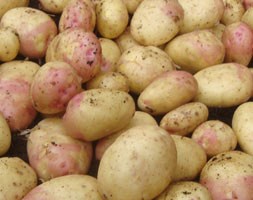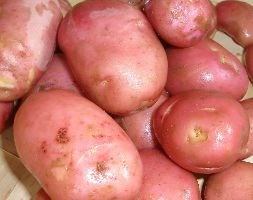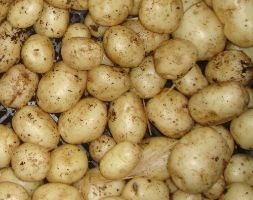Price reductions at Crocus
by Sarah - December 12th, 2013.Filed under: Crocus, Price Reductions.
Crocus has cut the price of these items
potato ‘Charlotte’ (potato – second early, Scottish basic seed potato) was £8.99 now £4.49
Position: sun-partial shade Soil: fertile, well drained Rate of growth: fast-growing Harvesting period: mid-late June Hardiness: protect tubers from frost Popular and high-yielding, these pear-shaped salad potatoes have a waxy flesh that maintains a good flavour when eaten hot or cold. Reliable and easy to grow in a wide range of soils, they have some resistance to scab and a good resistance to blight. If planted in summer, you can begin to harvest your new potatoes in late autumn to Christmas. Garden care: There is no need to chit seed potatoes which are planted in summer, so just plant them straight out into trenches dug into a well-prepared bed about 30cm (12in) apart, or plant them into a potato grow-bag, making sure there is at least 20cm (8″) of compost beneath them. Add a general purpose fertiliser to the bottom of the trench or growbag and then cover the potatoes with a 20cm layer of soil or compost. Keep well watered, and as the plants get to around 20cm (8in) tall you need to bank up the soil around the plant, so the soil covers the bottom two thirds of the plant. Watering your plants well will help improve crop yield and discourage potato scab. It is important that the crop is protected from frosts and the crop should be ready to harvest in around 12 weeks.
potato ‘Maris Piper’ (Potato – early maincrop) was £8.99 now £4.49
We sell potatoes by weight but you can expect to receive about 30-35 tubers of this variety in a 2.5kg bag. Position: sun-partial shade Soil: fertile, well drained Rate of growth: fast-growing Harvesting period: July Hardiness: protect tubers from frost A versatile, all-round early maincrop potato with dry, floury, cream-white flesh which rarely discolours on cooking. It is often considered the best potato for making chips. ‘Maris Piper’ is a high yielding variety, producing many tubers per plant and has good resistant to potato cyst nematode, damage, bruising, as well as being suitable for storage. Garden care: As soon as the potato tubers have bee n delivered you should unpack them and start the chitting (sprouting) process. Place them in single layer in a seed tray without compost and leave in a light, cool area protected from frost. This can be started about six weeks before you intend to plant them. Early varieties can be planted out under frost fleece protection, but the later varieties should be planted after the worst frosts have passed in your area – this is generally mid March to mid April. Dig a trench 8 – 13cm (3 – 5in) deep adding a general purpose fertiliser to the bottom of the trench. Plant the potato tubers in the trenches about 30cm (12in) apart, being careful not to knock the shoots off the tubers, and keeping the shoots facing upwards. Then lightly cover with soil. As the plants get to around 20cm (8in) tall you need to bank up the soil around the plant, so the soil covers the bottom two thirds of the plant. Watering your plants well will help improve crop yield and discourage potato scab.
potato ‘Red Duke of York’ (potato – first early, Scottish basic seed potato) was £8.99 now £4.49
We sell potatoes by weight but you can expect to receive about 25-30 tubers of this variety in a 2.5kg bag. Position: sun-partial shade Soil: fertile, well drained Rate of growth: fast-growing Harvesting period: early to mid June Hardiness: protect tubers from frost A Heritage early potato variety bred in 1942. This potato has a wonderful strong flavour and is a great all rounder – can be roasted, mashed, baked or used for making chips. Has deep red skin and pale yellow floury flesh, more vigorous with larger tubers than Duke of York. Garden care: As soon as the potato tubers have been delivered you should unpack them and start the chitting (sprouting) process. Place them in single layer in a seed tray without compost and leave in a light, cool area protected from frost. This can be started about six weeks before you intend to plant them. Early varieties can be planted out under frost fleece protection, but the later varieties should be planted after the worst frosts have passed in your area – this is generally mid March to mid April. Dig a trench 8 – 13cm (3 – 5in) deep adding a general purpose fertiliser to the bottom of the trench. Plant the potato tubers in the trenches about 30cm (12in) apart, being careful not to knock the shoots off the tubers, and keeping the shoots facing upwards. Then lightly cover with soil. As the plants get to around 20cm (8in) tall you need to bank up the soil around the plant, so the soil covers the bottom two thirds of the plant. Watering your plants well will help improve crop yield and discourage potato scab.
potato ‘Casablanca’ (PBR) (potato – first early, Scottish basic seed potato) was £8.99 now £4.49
Position: sun-partial shade Soil: fertile, well drained Rate of growth: fast-growing Harvesting period: June to July Hardiness: protect tubers from frost A new, multi-purpose first early potato with a smooth white skin, shallow eyes and a creamy flesh. It is a handsome potato, that is rapidly becoming the exhibitors favourite, while chefs are lapping it up because it is a dream to chip, bake or boil. It shows an excellent resistance to blackleg and it has been said that it can produce an edible crop just 62 days after planting. Garden care: As soon as the potato tubers have been delivered you should unpack them and start the chitting (sprouting) process. Place them in single layer in a seed tray without compost and leave in a light, cool area protected from frost. This can be started about six weeks before you intend to plant them. Early varieties can be planted out under frost fleece protection, but the later varieties should be planted after the worst frosts have passed in your area – this is generally mid March to mid April. Dig a trench 8 – 13cm (3 – 5in) deep adding a general purpose fertiliser to the bottom of the trench. Plant the potato tubers in the trenches about 30cm (12in) apart, being careful not to knock the shoots off the tubers, and keeping the shoots facing upwards. Then lightly cover with soil. As the plants get to around 20cm (8in) tall you need to bank up the soil around the plant, so the soil covers the bottom two thirds of the plant. Watering your plants well will help improve crop yield and discourage potato scab.
potato ‘Rocket’ (PBR) (potato – extra early salad, Scottish basic seed potato) was £8.99 now £4.49
We sell potatoes by weight but you can expect to receive about 25-30 tubers of this variety in a 2.5kg bag. Position: sun-partial shade Soil: fertile, well drained Rate of growth: fast-growing Harvesting period: early to mid June Hardiness: protect tubers from frost ‘Rocket’ is a very heavy cropping variety with pure white flesh, which is waxy and soft at first digging. Many customers have been delighted by the earliness, ease of culture and size of crop. It also has good all round disease resistance including golden eelworm. Garden care: As soon as the potato tubers have been delivered you should unpack them and start the chitting (sprouting) process. Place them in single layer in a seed tray without compost and leave in a light, cool area protected from frost. This can be started about six weeks before you intend to plant them. Early varieties can be planted out under frost fleece protection, but the later varieties should be planted after the worst frosts have passed in your area – this is generally mid March to mid April. Dig a trench 8 – 13cm (3 – 5in) deep adding a general purpose fertiliser to the bottom of the trench. Plant the potato tubers in the trenches about 30cm (12in) apart, being careful not to knock the shoots off the tubers, and keeping the shoots facing upwards. Then lightly cover with soil. As the plants get to around 20cm (8in) tall you need to bank up the soil around the plant, so the soil covers the bottom two thirds of the plant. Watering your plants well will help improve crop yield and discourage potato scab.
potato ‘Majestic’ (potato – maincrop, Scottish basic seed potato) was £8.99 now £4.49
We sell potatoes by weight but you can expect to receive about 25 tubers of this variety in a 2.5kg bag. Position: sun-partial shade Soil: fertile, well drained Rate of growth: fast-growing Harvesting period: Hardiness: protect tubers from frost ‘Majestic’ has been voted one of the ‘best varieties of the year’ by Sally Nex our Kitchen Garden blogger. She describes it as ”one of the best I’ve ever grown, putting in a fantastic yield”. First introduced in the 1940’s, it is still in demand today because it will grow in most soil types, has a floury white flesh with a richly aromatic flavour. It stores well too. Garden care: As soon as the potato tubers have been delivered you should unpack them and start the chitting (sprouting) process. Place them in single layer in a seed tray without compost and leave in a light, cool area protected from frost. This can be started about six weeks before you intend to plant them. Early varieties can be planted out under frost fleece protection, but the later varieties should be planted after the worst frosts have passed in your area – this is generally mid March to mid April. Dig a trench 8 – 13cm (3 – 5in) deep adding a general purpose fertiliser to the bottom of the trench. Plant the potato tubers in the trenches about 30cm (12in) apart, being careful not to knock the shoots off the tubers, and keeping the shoots facing upwards. Then lightly cover with soil. As the plants get to around 20cm (8in) tall you need to bank up the soil around the plant, so the soil covers the bottom two thirds of the plant. Watering your plants well will help improve crop yield and discourage potato scab.
potato ‘King Edward’ (potato – early maincrop, Scottish basic seed potato) was £8.99 now £4.49
We sell potatoes by weight but you can expect to receive about 30 tubers of this variety in a 2.5kg bag. Position: sun-partial shade Soil: fertile, well drained Rate of growth: fast-growing Harvesting period: Hardiness: protect tubers from frost Probably the most famous potato on the market, this early maincrop cooks well and tastes delicious. It also produces a high number of tubers per plant. It has good resistance to common scab, powdery scab, spraing, mild mosaic virus, slugs and bruising. A firm favourite, which has creamy-white flesh that rarely discolours on cooking, it is perfect for roasting and general kitchen use. Garden care: As soon as the potato tubers have been delivered you should unpack them and start the chitting (sprouting) process. Place them in single layer in a seed tray without compost and leave in a light, cool area protected from frost. This can be started about six weeks before you intend to plant them. Early varieties can be planted out under frost fleece protection, but the later varieties should be planted after the worst frosts have passed in your area – this is generally mid March to mid April. Dig a trench 8 – 13cm (3 – 5in) deep adding a general purpose fertiliser to the bottom of the trench. Plant the potato tubers in the trenches about 30cm (12in) apart, being careful not to knock the shoots off the tubers, and keeping the shoots facing upwards. Then lightly cover with soil. As the plants get to around 20cm (8in) tall you need to bank up the soil around the plant, so the soil covers the bottom two thirds of the plant. Watering your plants well will help improve crop yield and discourage potato scab.
potato ‘Desiree’ (potato – early maincrop Scottish basic seed potato) was £8.99 now £4.49
We sell potatoes by weight but you can expect to receive about 30 tubers of this variety in a 2.5kg bag. Position: sun-partial shade Soil: fertile, well drained Rate of growth: fast-growing Harvesting period: July Hardiness: protect tubers from frost Oval red skinned tubers with pale yellow flesh that keeps a firm texture when cooked, make these early maincrop potatoes firm favourites. They are heavy croppers that are tolerant of drought, and show a good resistance to potato virus and powdery scab. They are good all-rounders and make great roasties and wedges, as well as chips and mash. Garden care: As soon as the potato tubers have been delivered you should unpack them and start the chitting (sprouting) process. Place them in single layer in a seed tray without compost and leave in a light, cool area protected from frost. This can be started about six weeks before you intend to plant them. Early varieties can be planted out under frost fleece protection, but the later varieties should be planted after the worst frosts have passed in your area – this is generally mid March to mid April. Dig a trench 8 – 13cm (3 – 5in) deep adding a general purpose fertiliser to the bottom of the trench. Plant the potato tubers in the trenches about 30cm (12in) apart, being careful not to knock the shoots off the tubers, and keeping the shoots facing upwards. Then lightly cover with soil. As the plants get to around 20cm (8in) tall you need to bank up the soil around the plant, so the soil covers the bottom two thirds of the plant. Watering your plants well will help improve crop yield and discourage potato scab.
potato ‘Duke of York’ (potato – first early, Scottish basic seed potato) was £8.99 now £4.49
We sell potatoes by weight but you can expect to receive about 25-30 tubers of this variety in a 2.5kg bag. Position: sun-partial shade Soil: fertile, well drained Rate of growth: fast-growing Harvesting period: early to mid June Hardiness: protect tubers from frost A Heritage potato bred in 1891. This potato is much valued for its pale yellow tubers that have a super rich flavour. A classic first early which is low growing so ideal for a windy garden. Perfect for new potatoes but can be left to develop into a quality general purpose potato. All of our potatoes are certifed scottish seed potatoes ensuring crop quality Garden care: As soon as the potato tubers have been delivered you should unpack them and start the chitting (sprouting) process. Place them in single layer in a seed tray without compost and leave in a light, cool area protected from frost. This can be started about six weeks before you intend to plant them. Early varieties can be planted out under frost fleece protection, but the later varieties should be planted after the worst frosts have passed in your area – this is generally mid March to mid April. Dig a trench 8 – 13cm (3 – 5in) deep adding a general purpose fertiliser to the bottom of the trench. Plant the potato tubers in the trenches about 30cm (12in) apart, being careful not to knock the shoots off the tubers, and keeping the shoots facing upwards. Then lightly cover with soil. As the plants get to around 20cm (8in) tall you need to bank up the soil around the plant, so the soil covers the bottom two thirds of the plant. Watering your plants well will help improve crop yield and discourage potato scab.







